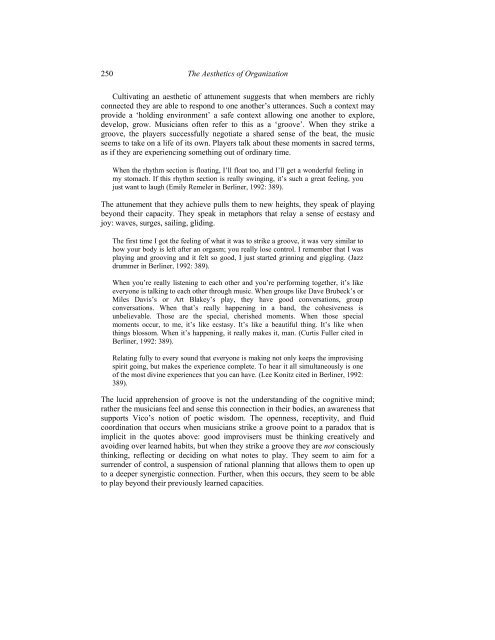Cultivating aesthetics - iSites
Cultivating aesthetics - iSites
Cultivating aesthetics - iSites
Create successful ePaper yourself
Turn your PDF publications into a flip-book with our unique Google optimized e-Paper software.
250<br />
The Aesthetics of Organization<br />
<strong>Cultivating</strong> an aesthetic of attunement suggests that when members are richly<br />
connected they are able to respond to one another’s utterances. Such a context may<br />
provide a ‘holding environment’ a safe context allowing one another to explore,<br />
develop, grow. Musicians often refer to this as a ‘groove’. When they strike a<br />
groove, the players successfully negotiate a shared sense of the beat, the music<br />
seems to take on a life of its own. Players talk about these moments in sacred terms,<br />
as if they are experiencing something out of ordinary time.<br />
When the rhythm section is floating, I’ll float too, and I’ll get a wonderful feeling in<br />
my stomach. If this rhythm section is really swinging, it’s such a great feeling, you<br />
just want to laugh (Emily Remeler in Berliner, 1992: 389).<br />
The attunement that they achieve pulls them to new heights, they speak of playing<br />
beyond their capacity. They speak in metaphors that relay a sense of ecstasy and<br />
joy: waves, surges, sailing, gliding.<br />
The first time I got the feeling of what it was to strike a groove, it was very similar to<br />
how your body is left after an orgasm; you really lose control. I remember that I was<br />
playing and grooving and it felt so good, I just started grinning and giggling. (Jazz<br />
drummer in Berliner, 1992: 389).<br />
When you’re really listening to each other and you’re performing together, it’s like<br />
everyone is talking to each other through music. When groups like Dave Brubeck’s or<br />
Miles Davis’s or Art Blakey’s play, they have good conversations, group<br />
conversations. When that’s really happening in a band, the cohesiveness is<br />
unbelievable. Those are the special, cherished moments. When those special<br />
moments occur, to me, it’s like ecstasy. It’s like a beautiful thing. It’s like when<br />
things blossom. When it’s happening, it really makes it, man. (Curtis Fuller cited in<br />
Berliner, 1992: 389).<br />
Relating fully to every sound that everyone is making not only keeps the improvising<br />
spirit going, but makes the experience complete. To hear it all simultaneously is one<br />
of the most divine experiences that you can have. (Lee Konitz cited in Berliner, 1992:<br />
389).<br />
The lucid apprehension of groove is not the understanding of the cognitive mind;<br />
rather the musicians feel and sense this connection in their bodies, an awareness that<br />
supports Vico’s notion of poetic wisdom. The openness, receptivity, and fluid<br />
coordination that occurs when musicians strike a groove point to a paradox that is<br />
implicit in the quotes above: good improvisers must be thinking creatively and<br />
avoiding over learned habits, but when they strike a groove they are not consciously<br />
thinking, reflecting or deciding on what notes to play. They seem to aim for a<br />
surrender of control, a suspension of rational planning that allows them to open up<br />
to a deeper synergistic connection. Further, when this occurs, they seem to be able<br />
to play beyond their previously learned capacities.
















